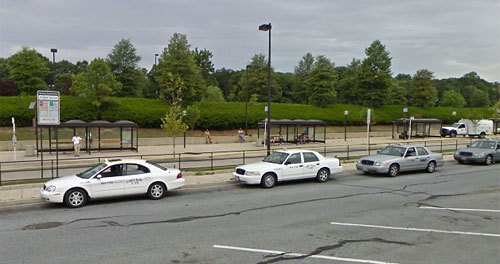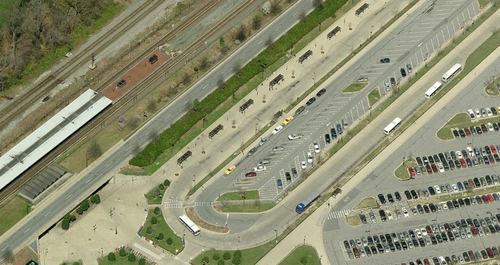Greenbelt bus riders need some shade
At the northern end of the Green Line, the Greenbelt station is a major bus transfer point. But passengers transferring between rail and bus face an unrelenting summer sun. In temperatures like those we saw this week, it can be a hellish wait for the bus.
The Greenbelt Metro station is a suburban park and ride. On the east side of the station, where the bus bays are located, is a large surface parking lot. With about 4,000 spaces, the sea of asphalt extends over a quarter-mile from the station entrance.
Behind the bus bays, a gentle, largely treeless slope leads up to the off-ramp from the Beltway into the station’s parking lot.
What this means is that the people waiting on their bus to come in have absolutely no shade. I don’t know if the mass of asphalt in the parking lot magnifies the heat or not, but the direct sunlight is bad enough on its own.
In the morning, riders cluster behind the small bus shelters. The thin layer of plexiglass is all the protection these riders can get. In the afternoon, riders can at least sit inside the shelters, though the protection is still thin and the shelter keeps out the breeze.
The nearest place riders can get any shade is in the station’s mezzanine. And since it’s quite a walk to get to the farther bays, it’s not an option for most riders to wait there.
This is not just about rider comfort. It’s about safety. On hot summer days, it’s only a matter of time until someone faints from heat exhaustion or heat stroke while waiting on the bus.
WMATA or Prince George’s County should consider taking steps to create some shade at the station. For the evening rush, that could be in the form of planting some trees on the slope behind the bus bays. The transit agency could also replace the transparent roofs on the bus shelters with opaque ones which would provide more shade.
Another approach could be similar to Phoenix’s. In the southwestern climate there, shade is far more important than rain protection. Stations on their new light rail line are primarily designed to shade waiting patrons. WMATA could also install shelters designed to shade riders, in addition to the ones intended to keep them dry.
An alternate though more expensive and long-term solution could include building a full canopy over the bus bays, like at Pentagon station.
Whatever the solution, an escape from the heat is necessary for bus riders at Greenbelt station.




